1 Introduction to Anthropology
Katie Nelson, Inver Hills Community College
knelson@inverhills.edu
http://kanelson.com/
Lara Braff, Grossmont College
lara.braff@gcccd.edu
Learning Objectives
-
Identify the four subfields of anthropology and describe the kinds of research projects associated with each subfield.
-
Define culture and the six characteristics of culture.
-
Describe how anthropology developed from early explorations of the world through the professionalization of the discipline in the nineteenth century.
-
Discuss ethnocentrism and the role it played in early attempts to understand other cultures.
-
Explain how the perspectives of holism, cultural relativism, comparison, and fieldwork, as well as both scientific and humanistic tendencies make anthropology a unique discipline.
-
Evaluate the ways in which anthropology can be used to address current social, political, and economic issues.
The first time I (Katie Nelson) heard the word anthropology, I was seventeen years old and sitting at the kitchen table in my home in rural Minnesota. My mother was stirring a pot of chili on the stove. My dog was barking (again) at the squirrels outside. Her low bawl filtered through the screen door left open on the porch. It was the summer before I was to start college and I had a Macalester College course catalog spread out in front of me as I set about carefully selecting the courses that would make up my fall class schedule. When I applied to college, I had indicated in my application that I was interested in studying creative writing, poetry specifically. But I also had a passion for languages and people: observing people, interacting with people and understanding people, especially those who were culturally different from myself. I noticed a course in the catalog entitled “Cultural Anthropology.” I did not know exactly what I would learn, but the course description appealed to me and I signed up for it. Several weeks later, I knew what my major would be– anthropology!
Like Katie, I (Lara Braff) started college with a curiosity about people but no clear major. In my second year, without knowing what anthropology was, I enrolled in an anthropology course called “Controlling Processes.” Throughout the semester, the professor encouraged us to question how social institutions (like the government, schools, etc.) affect the ways we think and act. This inquiry resonated with my upbringing: my mother, who had immigrated to the United States in her twenties, often questioned U.S. customs that were unfamiliar to her. At times, this was profoundly disappointing to me as a child. For example, she could not understand the joyous potential of filling up on candy at Halloween, a holiday not celebrated in her country. Yet, her outsider perspective inspired in me a healthy skepticism about things that others take to be “normal.” As I took more anthropology courses, I became intrigued by diverse notions of normality found around the world.
If you are reading this textbook for your first anthropology course, you are likely wondering, much like we did, what anthropology is all about. Perhaps the course description appealed to you in some way, but you had a hard time articulating what exactly drove you to enroll. With this book, you are in the right place!
WHAT IS ANTHROPOLOGY?
Derived from Greek, the word anthropos means “human” and “logy” refers to the “study of.” Quite literally, anthropology is the study of humanity. It is the study of everything and anything that makes us human.[1] From cultures, to languages, to material remains and human evolution, anthropologists examine every dimension of humanity by asking compelling questions like: How did we come to be human and who are our ancestors? Why do people look and act so differently throughout the world? What do we all have in common? How have we changed culturally and biologically over time? What factors influence diverse human beliefs and behaviors throughout the world?
You may notice that these questions are very broad. Indeed, anthropology is an expansive field of study. It is comprised of four subfields that in the United States include cultural anthropology, archaeology, biological (or physical) anthropology, and linguistic anthropology. Together, the subfields provide a multi-faceted picture of the human condition. Applied anthropology is another area of specialization within or between the anthropological subfields. It aims to solve specific practical problems in collaboration with governmental, non-profit, and community organizations as well as businesses and corporations.
It is important to note that in other parts of the world, anthropology is structured differently. For instance, in the United Kingdom and many European countries, the subfield of cultural anthropology is referred to as social (or socio-cultural) anthropology. Archaeology, biological anthropology, and linguistic anthropology are frequently considered to be part of different disciplines. In some countries, like Mexico, anthropology tends to focus on the cultural and indigenous heritage of groups within the country rather than on comparative research. In Canada, some university anthropology departments mirror the British social anthropology model by combining sociology and anthropology. As noted above, in the United States and most commonly in Canada, anthropology is organized as a four-field discipline. You will read more about the development of this four-field approach in the Doing Fieldwork chapter (chapter three).
WHAT IS CULTURAL ANTHROPOLOGY?
The focus of this textbook is cultural anthropology, the largest of the subfields in the United States as measured by the number of people who graduate with PhDs each year. Cultural anthropologists study the similarities and differences among living societies and cultural groups. Through immersive fieldwork, living and working with the people one is studying, cultural anthropologists suspend their own sense of what is “normal” in order to understand other people’s perspectives. Beyond describing another way of life, anthropologists ask broader questions about humankind: Are human emotions universal or culturally specific? Does globalization make us all the same, or do people maintain cultural differences? For cultural anthropologists, no aspect of human life is outside their purview. They study art, religion, healing, natural disasters, and even pet cemeteries. While many anthropologists are at first intrigued by human diversity, they come to realize that people around the world share much in common.
Cultural anthropologists often study social groups that differ from their own, based on the view that fresh insights are generated by an outsider trying to understand the insider point of view. For example, beginning in the 1960s Jean Briggs (1929-2016) immersed herself in the life of Inuit people in the central Canadian arctic territory of Nunavut. She arrived knowing only a few words of their language, but ready to brave sub-zero temperatures to learn about this remote, rarely studied group of people. In her most famous book, Never in Anger: Portrait of an Eskimo Family (1970), she argued that anger and strong negative emotions are not expressed among families that live together in small iglus amid harsh environmental conditions for much of the year. In contrast to scholars who see anger as an innate emotion, Briggs’ research shows that all human emotions develop through culturally specific child-rearing practices that foster some emotions and not others.
While cultural anthropologists traditionally conduct fieldwork in faraway places, they are increasingly turning their gaze inward to observe their own societies or subgroups within them. For instance, in the 1980s, American anthropologist Philippe Bourgois sought to understand why pockets of extreme poverty persist amid the wealth and overall high quality of life in the United States. To answer this question, he lived with Puerto Rican crack dealers in East Harlem, New York. He contextualized their experiences both historically in terms of their Puerto Rican roots and migration to the U.S. and in the present as they experienced social marginalization and institutional racism. Rather than blame the crack dealers for their poor choices or blame our society for perpetuating inequality, he argued that both individual choices and social structures can trap people in the overlapping worlds of drugs and poverty (Bourgois 2003). For more about Bourgois, please see the interview with him in the learning resources, Anthropology in Our Moment in History.
WHAT IS CULTURE?
Cultural anthropologists study all aspects of culture, but what exactly is “culture”? When we (the authors) first ask students in our introductory cultural anthropology courses what culture means to them, our students typically say that culture is food, clothing, religion, language, traditions, art, music, and so forth. Indeed, culture includes many of these observable characteristics, but culture is also something deeper. Culture is a powerful defining characteristic of human groups that shapes our perceptions, behaviors, and relationships.
One reason that culture is difficult to define is that it encompasses all the intangible qualities that make people who they are. Culture is the “air we breathe:” it sustains and comprises us, yet we largely take it for granted. We are not always consciously aware of our own culture.
Furthermore, cultural anthropologists themselves do not always agree on what culture is. In defining culture, some anthropologists emphasize material life and objects (e.g. tools, clothing, and technologies); others emphasize culture as a system of intangible beliefs; and still others focus on practices or customs of daily life. We propose a broad definition of culture.[2]
Culture is a set of beliefs, practices, and symbols that are learned and shared. Together, they form an all-encompassing, integrated whole that binds people together and shapes their worldview and lifeways.
To say that a group of people shares a culture does not mean all individuals think or act in identical ways. One’s beliefs and practices can vary within a culture depending on age, gender, social status, and other characteristics. Yet, members of a culture share many things in common. While we are not born with a particular culture, we are born with the capacity to learn any culture. Through the process of enculturation, we learn to become members of our group both directly, through instruction from our parents and peers, and indirectly by observing and imitating those around us.
Culture constantly changes in response to both internal and external factors. Some parts of culture change more quickly than others. For instance, in dominant American culture, technology changes rapidly while deep seated values such as individualism, freedom, and self-determination change very little over time. Yet, inevitably, when one part of culture changes, so do other parts. This is because nearly all parts of a culture are integrated and interrelated. As powerful as culture is, humans are not necessarily bound by culture; they have the capacity to conform to it or not and even transform it.
In the definition above, belief refers not just to what we “believe” to be right or wrong, true or false. Belief also refers to all the mental aspects of culture including values, norms, philosophies, worldview, knowledge, and so forth. Practices refers to behaviors and actions that may be motivated by belief or performed without reflection as part of everyday routines.
Much like art and language, culture is also symbolic. A symbol is something that stands for something else, often without a natural connection. Individuals create, interpret, and share the meanings of symbols within their group or the larger society. For example, in U.S. society everyone recognizes a red octagonal sign as signifying “stop.” In other cases, groups within American society interpret the same symbol in different ways. Take the Confederate flag: Some people see it as a symbol of pride in a southern heritage. Many others see it as a symbol of the long legacy of slavery, segregation, and racial oppression. Thus, displaying the Confederate flag could have positive or, more often, negative connotations. Cultural symbols powerfully convey either shared or conflicting meanings across space and time.
This definition of culture – shared, learned beliefs, practices, and symbols – allows us to understand that people everywhere are thinkers and actors shaped by their social contexts. As we will see throughout this book, these contexts are incredibly diverse, comprising the human cultural diversity that drew many of us to become anthropologists in the first place.
While culture is central to making us human, we are still biological beings with natural needs and urges that we share with other animals: hunger, thirst, sex, elimination, etc. Human culture uniquely channels these urges in particular ways and cultural practices can then impact our biology, growth, and development. Humans are one of the most dynamic species on Earth. Our ability to change both culturally and biologically has enabled us to persist for millions of years and to thrive in diverse environments.
Characteristics of Culture
Culture is a set of beliefs, practices, and symbols that are learned and shared. Together, they form an all-encompassing, integrated whole that binds groups of people together and shapes their worldview and lifeways. Additionally:
-
Humans are born with the capacity to learn the culture of any social group. We learn culture both directly and indirectly.
-
Culture changes in response to both internal and external factors.
-
Humans are not bound by culture; they have the capacity to conform to it or not, and sometimes change it.
-
Culture is symbolic; individuals create and share the meanings of symbols within their group or society.
-
The degree to which humans rely on culture distinguishes us from other animals and shaped our evolution.
-
Human culture and biology are interrelated: Our biology, growth, and development are impacted by culture.
A BRIEF HISTORY OF ANTHROPOLOGICAL THINKING
Imagine you are living several thousand years ago. Maybe you are a wife and mother of three children. Maybe you are a young man eager to start your own family. Maybe you are a prominent religious leader, or maybe you are a respected healer. Your family has, for as long as people can remember, lived the way you do. You learned to act, eat, hunt, talk, pray, and live the way you do from your parents, your extended family, and your small community. Suddenly, you encounter a new group of people who have a different way of living, speak strangely, and eat in an unusual manner. They have a different way of addressing the supernatural and caring for their sick. What do you make of these differences? These are the questions that have faced people for tens of thousands of years as human groups have moved around and settled in different parts of the world.
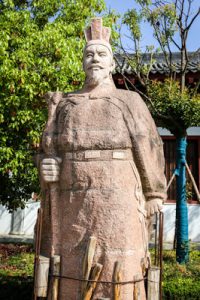
One of the first examples of someone who attempted to systematically study and document cultural differences is Zhang Qian (164 BC – 113 BC). Born in the second century BCE in Hanzhong, China, Zhang was a military officer who was assigned by Emperor Wu of Han to travel through Central Asia, going as far as what is today Uzbekistan. He spent more than twenty-five years traveling and recording his observations of the peoples and cultures of Central Asia (Wood 2004). The Emperor used this information to establish new relationships and cultural connections with China’s neighbors to the West. Zhang discovered many of the trade routes used in the Silk Road and introduced several new cultural ideas, including Buddhism, into Chinese culture.
Another early traveler of note was Abu Abdullah Muhammad Ibn Battuta, known most widely as Ibn Battuta, (1304-1369). Ibn Battuta was an Amazigh (Berber) Moroccan Muslim scholar. During the fourteenth century, he traveled for a period of nearly thirty years, covering almost the whole of the Islamic world, including parts of Europe, sub-Saharan Africa, India, and China. Upon his return to the Kingdom of Morocco, he documented the customs and traditions of the people he encountered in a book called Tuhfat al-anzar fi gharaaib al-amsar wa ajaaib al-asfar (A Gift to those who Contemplate the Wonders of Cities and the Marvels of Traveling), a book commonly known as Al Rihla, which means “travels” in Arabic (Mackintosh-Smith 2003: ix). This book became part of a genre of Arabic literature that included descriptions of the people and places visited along with commentary about the cultures encountered. Some scholars consider Al Rihla to be among the first examples of early pre-anthropological writing.[3]
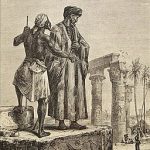
Later, from the 1400s through the1700s, during the so-called “Age of Discovery,” Europeans began to explore the world, and then colonize it. Europeans exploited natural resources and human labor in other parts of the world, exerting social and political control over the people they encountered. New trade routes along with the slave trade fueled a growing European empire while forever disrupting previously independent cultures in the Old World. European ethnocentrism—the belief that one’s own culture is better than others—was used to justify the subjugation of non-European societies on the alleged basis that these groups were socially and even biologically inferior. Indeed, the emerging anthropological practices of this time were ethnocentric and often supported colonial projects.
As European empires expanded, new ways of understanding the world and its people arose. Beginning in the eighteenth century in Europe, the Age of the Enlightenment was a social and philosophical movement that privileged science, rationality, and experience, while critiquing religious authority. This crucial period of intellectual development planted the seeds for many academic disciplines, including anthropology. It gave ordinary people the capacity to learn the “truth” through observation and experience: anyone could ask questions and use rational thought to discover things about the natural and social world.

For example, geologist Sir Charles Lyell (1797-1875) observed layers of rock and argued that the earth’s surface must have changed gradually over long periods of time. He disputed the Young Earth theory, which was popular at the time and used Biblical information to date the earth as only 6,000 years old, Charles Darwin (1809-1882), a naturalist and biologist, observed similarities between fossils and living specimens, leading him to argue that all life is descended from a common ancestor. Philosopher John Locke (1632-1704) contemplated the origins of society itself, proposing that people historically had lived in relative isolation until they agreed to form a society in which the government would protect their personal property.
These radical ideas about the earth, evolution, and society influenced early social scientists into the nineteenth century. Philosopher and anthropologist Herbert Spencer (1820-1903), inspired by scientific principles, used biological evolution as a model to understand social evolution. Just as biological life evolved from simple to complex multicellular organisms, he postulated that societies “evolve” to become larger and more complex. Anthropologist Lewis Henry Morgan (1818-1881) argued that all societies “progress” through the same stages of development: savagery—barbarism—civilization. Societies were classified into these stages based on their family structure, technologies, and methods for acquiring food. So-called “savage” societies, ones that used stone tools and foraged for food, were said to be stalled in their social, mental, and even moral development.
Ethnocentric ideas like Morgan’s were challenged by anthropologists in the early twentieth century in both Europe and the United States. During World War I, Bronislaw Malinowski (1884-1942), a Polish anthropologist, became stranded on the Trobriand Islands located north of Australia and Papua New Guinea. While there, he started to develop participant-observation fieldwork: the method of immersive, long-term research that cultural anthropologists use today. By living with and observing the Trobriand Islanders, he realized that their culture was not “savage,” but was well-suited to fulfill the needs of the people. He developed a theory to explain human cultural diversity: each culture functions to satisfy the specific biological and psychological needs of its people. While this theory has been critiqued as biological reductionism, it was an early attempt to view other cultures in more open-minded ways.
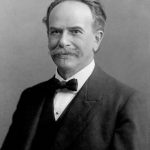
Around the same time in the United States, Franz Boas (1858-1942), widely regarded as the founder of American anthropology, developed cultural relativism, the view that while cultures differ, they are not better or worse than one another. In his critique of ethnocentric views, Boas insisted that physical and behavioral differences among racial and ethnic groups in the United States were shaped by environmental and social conditions, not biology. In fact, he argued that culture and biology are distinct realms of experience: human behaviors are socially learned, contextual, and flexible, not innate. Further, Boas worked to transform anthropology into a professional and empirical academic discipline that integrated the four subdisciplines of cultural anthropology, linguistic anthropology, archaeology, and biological anthropology.
THE (OTHER) SUBFIELDS OF ANTHROPOLOGY
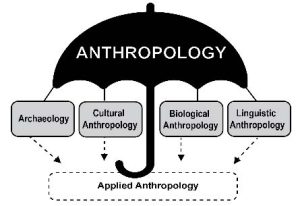
Biological Anthropology
Biological anthropology is the study of human origins, evolution, and variation. Some biological anthropologists focus on our closest living relatives, monkeys and apes. They examine the biological and behavioral similarities and differences between nonhuman primates and human primates (us!). For example, Jane Goodall has devoted her life to studying wild chimpanzees (Goodall 1996). When she began her research in Tanzania in the 1960s, Goodall challenged widely held assumptions about the inherent differences between humans and apes. At the time, it was assumed that monkeys and apes lacked the social and emotional traits that made human beings such exceptional creatures. However, Goodall discovered that, like humans, chimpanzees also make tools, socialize their young, have intense emotional lives, and form strong maternal-infant bonds. Her work highlights the value of field-based research in natural settings that can help us understand the complex lives of nonhuman primates.
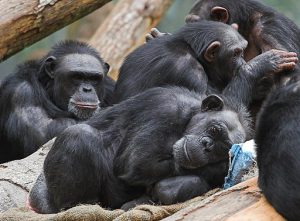
Other biological anthropologists focus on extinct human species, asking questions like: What did our ancestors look like? What did they eat? When did they start to speak? How did they adapt to new environments? In 2013, a team of women scientists excavated a trove of fossilized bones in the Dinaledi Chamber of the Rising Star Cave system in South Africa. The bones turned out to belong to a previously unknown hominin species that was later named Homo naledi. With over 1,550 specimens from at least fifteen individuals, the site is the largest collection of a single hominin species found in Africa (Berger, 2015). Researchers are still working to determine how the bones were left in the deep, hard to access cave and whether or not they were deliberately placed there. They also want to know what Homo naledi ate, if this species made and used tools, and how they are related to other Homo species. Biological anthropologists who study ancient human relatives are called paleoanthropologists. The field of paleoanthropology changes rapidly as fossil discoveries and refined dating techniques offer new clues into our past.
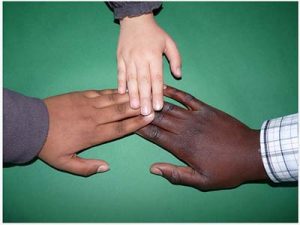
Other biological anthropologists focus on humans in the present including their genetic and phenotypic (observable) variation. For instance, Nina Jablonski has conducted research on human skin tone, asking why dark skin pigmentation is prevalent in places, like Central Africa, where there is high ultraviolet (UV) radiation from sunlight, while light skin pigmentation is prevalent in places, like Nordic countries, where there is low UV radiation. She explains this pattern in terms of the interplay between skin pigmentation, UV radiation, folic acid, and vitamin D. In brief, too much UV radiation can break down folic acid, which is essential to DNA and cell production. Dark skin helps block UV, thereby protecting the body’s folic acid reserves in high-UV contexts. Light skin evolved as humans migrated out of Africa to low-UV contexts, where dark skin would block too much UV radiation, compromising the body’s ability to absorb vitamin D from the sun. Vitamin D is essential to calcium absorption and a healthy skeleton. Jablonski’s research shows that the spectrum of skin pigmentation we see today evolved to balance UV exposure with the body’s need for vitamin D and folic acid (Jablonski 2012).
Archaeology
Archaeologists focus on the material past: the tools, food, pottery, art, shelters, seeds, and other objects left behind by people. Prehistoric archaeologists recover and analyze these materials to reconstruct the lifeways of past societies that lacked writing. They ask specific questions like: How did people in a particular area live? What did they eat? Why did their societies to change over time? They also ask general questions about humankind: When and why did humans first develop agriculture? How did cities first develop? How did prehistoric people interact with their neighbors?
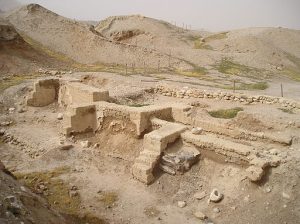
The method that archaeologists use to answer their questions is excavation—the careful digging and removing of dirt and stones to uncover material remains while recording their context. Archaeological research spans millions of years from human origins to the present. For example, British archaeologist Kathleen Kenyon (1906-1978), was one of few female archaeologists in the 1940s. She famously studied the city structures and cemeteries of Jericho, an ancient city dating back to the Early Bronze Age (3,200 years before the present) located in what is today the West Bank. Based on her findings, she argued that Jericho is the oldest city in the world and has been continuously occupied by different groups for over 10,000 years (Kenyon 1979).
Historical archaeologists study recent societies using material remains to complement the written record. The Garbage Project, which began in the 1970s, is an example of a historic archaeological project based in Tucson, Arizona. It involves excavating a contemporary landfill as if it were a conventional archaeology site. Archaeologists have found discrepancies between what people say they throw out and what is actually in their trash. In fact, many landfills hold large amounts of paper products and construction debris (Rathje and Murphy 1992). This finding has practical implications for creating environmentally sustainable waste disposal practices.
In 1991, while working on an office building in New York City, construction workers came across human skeletons buried just 30 feet below the city streets. Archaeologists were called in to investigate. Upon further excavation, they discovered a six-acre burial ground, containing 15,000 skeletons of free and enslaved Africans who helped build the city during the colonial era. The “African Burial Ground,” which dates dating from 1630 to 1795, contains a trove of information about how free and enslaved Africans lived and died. The site is now a national monument where people can learn about the history of slavery in the U.S.[4]
Linguistic Anthropology
Language is a defining trait of human beings. While other animals have communication systems, only humans have complex, symbolic languages—over 6,000 of them! Human language makes it possible to teach and learn, to plan and think abstractly, to coordinate our efforts, and even to contemplate our own demise. Linguistic anthropologists ask questions like: How did language first emerge? How has it evolved and diversified over time? How has language helped us succeed as a species? How can language convey one’s social identity? How does language influence our views of the world? If you speak two or more languages, you may have experienced how language affects you. For example, in English, we say: “I love you.” But Spanish speakers use different terms—te amo, te adoro, te quiero, and so on—to convey different kinds of love: romantic love, platonic love, maternal love, etc. The Spanish language arguably expresses more nuanced views of love than the English language.

One intriguing line of linguistic anthropological research focuses on the relationship between language, thought, and culture. It may seem intuitive that our thoughts come first; after all, we like to say: “Think before you speak.” However, according to the Sapir-Whorf Hypothesis (also known as linguistic relativity), the language you speak allows you to think about some things and not others. When Benjamin Whorf (1897-1941) studied the Hopi language, he found not just word-level differences, but grammatical differences between Hopi and English. He wrote that Hopi has no grammatical tenses to convey the passage of time. Rather, the Hopi language indicates whether or not something has “manifested.” Whorf argued that English grammatical tenses (past, present, future) inspire a linear sense of time, while Hopi language, with its lack of tenses, inspires a cyclical experience of time (Whorf 1956). Some critics, like German-American linguist Ekkehart Malotki, refute Whorf’s theory, arguing that Hopi do have linguistic terms for time and that a linear sense of time is natural and perhaps universal. At the same time, Malotki recognized that English and Hopi tenses differ, albeit in ways less pronounced than Whorf proposed (Malotki 1983).
Other linguistic anthropologists track the emergence and diversification of languages, while others focus on language use in today’s social contexts. Still others explore how language is crucial to socialization: children learn their culture and social identity through language and nonverbal forms of communication (Ochs and Schieffelin 2012).
Applied Anthropology
Sometimes considered a fifth subdiscipline, applied anthropology involves the application of anthropological theories, methods, and findings to solve practical problems. Applied anthropologists are employed outside of academic settings, in both the public and private sectors, including business or consulting firms, advertising companies, city government, law enforcement, the medical field, nongovernmental organizations, and even the military.
Applied anthropologists span the subfields. An applied archaeologist might work in cultural resource management to assess a potentially significant archaeological site unearthed during a construction project. An applied cultural anthropologist could work at a technology company that seeks to understand the human-technology interface in order to design better tools.
Medical anthropology is an example of both an applied and theoretical area of study that draws on all four subdisciplines to understand the interrelationship of health, illness, and culture. Rather than assume that disease resides only within the individual body, medical anthropologists explore the environmental, social, and cultural conditions that impact the experience of illness. For example, in some cultures, people believe illness is caused by an imbalance within the community. Therefore, a communal response, such as a healing ceremony, is necessary to restore both the health of the person and the group. This approach differs from the one used in mainstream U.S. healthcare, whereby people go to a doctor to find the biological cause of an illness and then take medicine to restore the individual body.
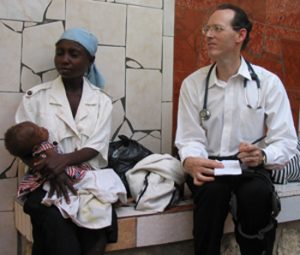
Trained as both a physician and medical anthropologist, Paul Farmer demonstrates the applied potential of anthropology. During his college years in North Carolina, Farmer’s interest in the Haitian migrants working on nearby farms inspired him to visit Haiti. There, he was struck by the poor living conditions and lack of health care facilities. Later, as a physician, he would return to Haiti to treat individuals suffering from diseases like tuberculosis and cholera that were rarely seen in the United States. As an anthropologist, he would contextualize the experiences of his Haitian patients in relation to the historical, social, and political forces that impact Haiti, the poorest country in the Western Hemisphere (Farmer 2006). Today, he not only writes academic books about human suffering, he also takes action. Through the work of Partners in Health, a nonprofit organization that he co-founded, he has helped open health clinics in many resource-poor countries and trained local staff to administer care. In this way, he applies his medical and anthropological training to improve people’s lives.
ANTHROPOLOGICAL PERSPECTIVES
Anthropologists across the subfields use unique perspectives to conduct their research. These perspectives make anthropology distinct from related disciplines — like history, sociology, and psychology — that ask similar questions about the past, societies, and human nature. The key anthropological perspectives are holism, relativism, comparison, and fieldwork. There are also both scientific and humanistic tendencies within the discipline that, at times, conflict with one another.
Holism
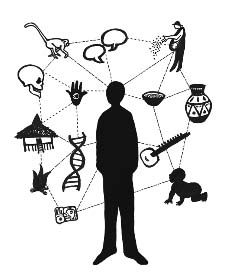
Anthropologists are interested in the whole of humanity, in how various aspects of life interact. One cannot fully appreciate what it means to be human by studying a single aspect of our complex histories, languages, bodies, or societies. By using a holistic approach, anthropologists ask how different aspects of human life influence one another. For example, a cultural anthropologist studying the meaning of marriage in a small village in India might consider local gender norms, existing family networks, laws regarding marriage, religious rules, and economic factors. A biological anthropologist studying monkeys in South America might consider the species’ physical adaptations, foraging patterns, ecological conditions, and interactions with humans in order to answer questions about their social behaviors. By understanding how nonhuman primates behave, we discover more about ourselves (after all, humans are primates)! By using a holistic approach, anthropologists reveal the complexity of biological, social, or cultural phenomena.
Anthropology itself is a holistic discipline, comprised in the United States (and in some other nations) of four major subfields: cultural anthropology, biological anthropology, linguistic anthropology, and archaeology. While anthropologists often specialize in one subfield, their specific research contribute to a broader understanding of the human condition, which is made up of culture, language, biological and social adaptations, as well as human origins and evolution.
Cultural Relativism (versus Ethnocentrism)
The guiding philosophy of modern anthropology is cultural relativism—the idea that we should seek to understand another person’s beliefs and behaviors from the perspective of their culture rather than our own. Anthropologists do not judge other cultures based on their values nor do they view other ways of doing things as inferior. Instead, anthropologists seek to understand people’s beliefs within the system they have for explaining things.
The opposite of cultural relativism is ethnocentrism, the tendency to view one’s own culture as the most important and correct and as a measuring stick by which to evaluate all other cultures that are largely seen as inferior and morally suspect. As it turns out, many people are ethnocentric to some degree; ethnocentrism is a common human experience. Why do we respond the way we do? Why do we behave the way we do? Why do we believe what we believe? Most people find these kinds of questions difficult to answer. Often the answer is simply “because that is how it is done.” People typically believe that their ways of thinking and acting are “normal”; but, at a more extreme level, some believe their ways are better than others.
Ethnocentrism is not a useful perspective in contexts in which people from different cultural backgrounds come into close contact with one another, as is the case in many cities and communities throughout the world. People increasingly find that they must adopt culturally relativistic perspectives in governing communities and as a guide for their interactions with members of the community. For anthropologists, cultural relativism is especially important. We must set aside our innate ethnocentric views in order to allow cultural relativism to guide our inquiries and interactions such that we can learn from others.
Comparison
Anthropologists of all the subfields use comparison to learn what humans have in common, how we differ, and how we change. Anthropologists ask questions like: How do chimpanzees differ from humans? How do different languages adapt to new technologies? How do countries respond differently to immigration? In cultural anthropology, we compare ideas, morals, practices, and systems within or between cultures. We might compare the roles of men and women in different societies, or contrast how different religious groups conflict within a given society. Like other disciplines that use comparative approaches, such as sociology or psychology, anthropologists make comparisons between people in a given society. Unlike these other disciplines, anthropologists also compare across societies, and betweeen humans and other primates. In essence, anthropological comparisons span societies, cultures, time, place, and species. It is through comparison that we learn more about the range of possible responses to varying contexts and problems.
Fieldwork
Anthropologists conduct their research in the field with the species, civilization, or groups of people they are studying. In cultural anthropology, our fieldwork is referred to as ethnography, which is both the process and result of cultural anthropological research. The Greek term “ethno” refers to people, and “graphy” refers to writing. The ethnographic process involves the research method of participant-observation fieldwork: you participate in people’s lives, while observing them and taking field notes that, along with interviews and surveys, constitute the research data. This research is inductive: based on day-to-day observations, the anthropologist asks increasingly specific questions about the group or about the human condition more broadly. Oftentimes, informants actively participate in the research process, helping the anthropologist ask better questions and understand different perspectives.
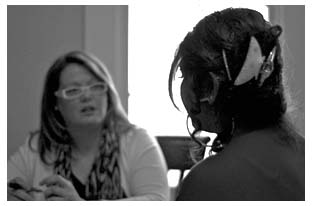
The word ethnography also refers to the end result of our fieldwork. Cultural anthropologists do not write “novels,” rather they write ethnographies, descriptive accounts of culture that weave detailed observations with theory. After all, anthropologists are social scientists. While we study a particular culture to learn more about it and to answer specific research questions, we are also exploring fundamental questions about human society, behavior, or experiences.
In the course of conducting fieldwork with human subjects, anthropologists invariably encounter ethical dilemmas: Who might be harmed by conducting or publishing this research? What are the costs and benefits of identifying individuals involved in this study? How should one resolve competing interests of the funding agency and the community? To address these questions, anthropologists are obligated to follow a professional code of ethics that guide us through ethical considerations in our research.[5]
Scientific vs Humanistic Approaches
As you may have noticed from the above discussion of the anthropological sub-disciplines, anthropologists are not unified in what they study or how they conduct research. Some sub-disciplines, like biological anthropology and archaeology, use a deductive, scientific approach. Through hypothesis testing, they collect and analyze material data (e.g. bones, tools, seeds, etc.) to answer questions about human origins and evolution. Other subdisciplines, like cultural anthropology and linguistic anthropology, use humanistic and/or inductive approaches to their collection and analysis of nonmaterial data, like observations of everyday life or language in use.
At times, tension has arisen between the scientific subfields and the humanistic ones. For example, in 2010 some cultural anthropologists critiqued the American Anthropological Association’s mission statement, which stated that the discipline’s goal was “to advance anthropology as the science that studies humankind in all its aspects.”[6] These scholars wanted to replace the word “science” with “public understanding.” They argued that some anthropologists do not use the scientific method of inquiry; instead, they rely more on narratives and interpretations of meaning. After much debate, the word “science” remains in the mission statement and, throughout the United States, anthropology is predominantly categorized as a social science.
WHY IS ANTHROPOLOGY IMPORTANT?
As we hope you have learned thus far, anthropology is an exciting and multifaceted field of study. Because of its breadth, students who study anthropology go on to work in a wide variety of careers in medicine, museums, field archaeology, historical preservation, education, international business, documentary filmmaking, management, foreign service, law, and many more. Beyond preparing students for a particular career, anthropology helps people develop essential skills that are transferable to many career choices and life paths. Studying anthropology fosters broad knowledge of other cultures, skills in observation and analysis, critical thinking, clear communication, and applied problem-solving. Anthropology encourages us to extend our perspectives beyond familiar social contexts to view things from the perspectives of others. As one former cultural anthropology student observed, “I believe an anthropology course has one basic goal: to eliminate ethnocentrism. A lot of issues we have today (racism, xenophobia, etc.) stem from the toxic idea that people are ‘other’ We must put that idea aside and learn to value different cultures.”[7] This anthropological perspective is an essential skill for nearly any career in today’s globalized world.
Some students decide to major in anthropology and even pursue advanced academic degrees in order to become professional anthropologists. We asked three cultural anthropologists – Anthony Kwame Harrison, Bob Myers, and Lynn Kwiatkowski – to describe what drew them to the discipline and to explain how they use anthropological perspectives in their varied research projects. From the study of race in the United States, to health experiences on the island of Dominica, to hunger and gender violence in the Philippines, these anthropologists all demonstrate the endless potential of the discipline.
Anthony Kwame Harrison, PhD
Cultural Anthropologist, Virginia Polytechnic Institute and State University
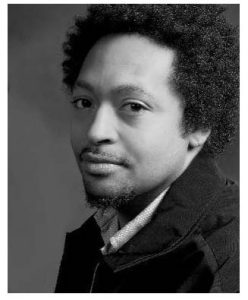
I like to tell a story about how, on the last day of my first year at the University of Massachusetts, while sitting alone in my dorm room waiting to be picked up, I decided to figure out what my major would be. So, I opened the course catalogue—back then it was a physical book—and started going through it alphabetically.
On days when I am feeling particularly playful, I say that after getting through the A’s, I knew Anthropology was for me. In truth, I also considered Zoology. I was initially drawn to anthropology because of its traditional focus on exoticness and difference. I was born in Ghana, West Africa, where my American father had spent several years working with local artisans at the National Cultural Centre in Kumasi. My family moved to the United States when I was still a baby; and I had witnessed my Asante mother struggle with adapting to certain aspects of life in America. Studying anthropology, then, gave me a reason to learn more about the unusual artwork that filled my childhood home and to connect with a faraway side of my family that I hardly knew anything about.
Looking through that course catalogue, I didn’t really know what anthropology was but resolved to test-the-waters by taking several classes the following year. As I flourished in these courses—two introductory level classes on cultural anthropology and archeology, a class called “Culture through Film,” and another on “Egalitarian Societies”—I envisioned a possible future as an anthropologist working in rural West Africa on topics like symbolic art and folklore. I never imagined I would earn a Ph.D. researching the mostly middle-class, largely multi-racial, independent hip-hop scene in the San Francisco Bay Area.
Through my anthropological training, I have made a career exploring how race influences our perceptions of popular music. I have written several pieces on racial identity and hip hop—most notably my 2009 book, Hip Hop Underground: The Integrity and Ethics of Racial Identification. I have also explored how race impacts people’s senses of belonging in various social spaces—for instance, African American participation in downhill skiing or the experiences of underrepresented students at historically white colleges and universities. In all these efforts, my attention is primarily on understanding the complexities, nuances, and significance of race. I use these other topics—music, recreation, and higher education—as avenues through which to explore race’s multiple meanings and unequal consequences.
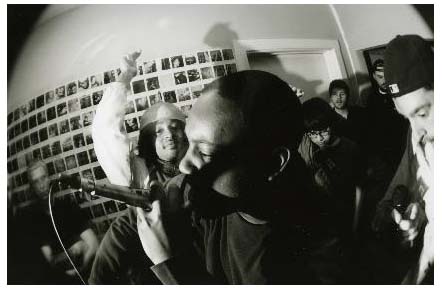
Where a fascination with the exotic initially brought me to anthropology, it is the discipline’s ability to shed light on what many of us see as normal, common, and taken-for-granted that has kept me with it through three degrees (bachelor’s, master’s, and Ph.D.) and a fifteen-year career as a college professor. I am currently the Gloria D. Smith Professor of Africana Studies at Virginia Tech—a school that, oddly enough, does not have an anthropology program. Being an anthropologist at a major university that doesn’t have an anthropology program, I believe, gives me a unique perspective on the discipline’s key virtues.
One of the most important things that anthropology does is create a basis for questioning taken-for-granted notions of progress. Does the Gillette Fusion Five Razor, with its five blades, really offer a better shave than the four-bladed Schick Quattro? I cannot say for sure, but as I’ve witnessed the move from twin-blade razors, to Mach 3s, to today (there is even a company offering “the world’s first and only” razor with “seven precision aligned blades)” there appears to be a presumption that more, in this case, razor-blades is better. I’ll admit that the razor-blade example is somewhat crude. Expanding out to the latest model automobile or smartphone, people seem to have a seldom questioned belief in the notion that newer technologies ultimately improve our lives. Anthropology places such ideas within the broader context of human lifeways, or what anthropologists call culture. What are the most crucial elements of human biological and social existence? What additional developments have brought communities the greatest levels of collective satisfaction, effective organization, and sustainability?

Anthropology has taught me to view the contemporary American lifestyle that I grew up thinking was normal through the wider frame of humanity’s long history. How does our perspective change upon learning that for the vast majority of human history—some say as much as ninety-nine percent of it—people lived a foraging lifestyle (commonly referred to as “hunting and gathering”)? Although I am not calling for a mass return to foraging, when we consider the significant worldwide issues that humans face today—such things as global warming, the threat of nuclear war, accelerating ethnic conflicts, and a world population that has grown from one billion to nearly eight billion over the past two hundred years—we are left with difficult questions about whether 10,000 years of agriculture and a couple hundred years of industrialization have been in humanity’s best long-term interests. All of this is to say that anthropology offers one of the most biting critiques of modernity, which challenges us to slow down and think about whether the new technologies we are constantly being presented with make sense. Similarly, the anthropological concept of ethnocentrism is incredibly useful when paired with different examples of how people define family, recognize leadership, decide what is and is not edible, and the like. To offer just one example, many of my students are surprised to learn that among my (matrilineal) family in Ghana, I have a distinctly different relationship with cousins who are children of my mother’s brother as compared with cousins who are children of her sister.
Using my own anthropological biography as an illustration, I want to stress that the discipline does not showcase diverse human lifeways to further exoticize those who live differently from us. In contrast, anthropology showcases cultural variation to illustrate the possibilities and potential for human life, and to demonstrate that the way of doing things we know best is neither normal nor necessarily right. It is just one way among a multitude of others. “Everybody does it but we all do it different”; this is culture.
Bob Myers, PhD, M.P.H.
Cultural Anthropologist, Alfred University
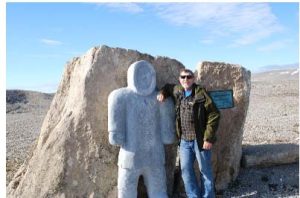
My undergraduate experience significantly shaped my attitudes about education in general and anthropology in particular. At Davidson College in North Carolina I completed a German major, minored in Biology and took many courses in English Literature. I also spent one year studying abroad at Philipps Universität in Marburg, Germany, and saved some “me time” for hitchhiking and traveling around Europe. This led me to pursue graduate work in anthropology despite the fact that I had taken only one anthropology course in college. While in graduate school at the University of North Carolina at Chapel Hill, I became fascinated with Caribbean history and migration and spent almost two years doing doctoral fieldwork and research on the island of Dominica. After finishing my PhD, I had a one-year post-doc in biostatistics in Chapel Hill before I took my first job at Davidson College where I taught for several years.[8]
Observations of an impoverished health system in Dominica and family health experiences with dysentery during fieldwork led me toward medical anthropology and public health and so I completed a M.P.H. degree at the Harvard School of Public Health before receiving a Fulbright Fellowship to go to Benin University in southern Nigeria. There, a coup and other circumstances turned my one-year fellowship into a two-year experience/adventure. I probably learned more anthropology in Nigeria than in all of graduate school, including examples of the power of a traditional kingdom and the ways large families enable members to manage in distressing economic conditions. Then I went back to the U.S. and taught for two years at Long Island University before moving to rural Alfred University in western New York, where I now work. Alfred is a diverse university with a world class engineering program, a nationally ranked BFA/MFA program, small business, school psychology, and liberal arts and sciences programs, and no anthropology other than what I’ve been teaching for 32 years. To offset the absence of other anthropologists, colleagues in religious studies and I created a major called Comparative Cultures and later, with colleagues in modern languages, environmental studies, and political science, a Global Studies major, a perfect multi-disciplinary setting for anthropology.
Anthropology is the broadest, most fundamental of academic subjects and should be at the core of a modern undergraduate education. I’m convinced that an anthropology major is not necessary for our discipline to play a significant role in students’ understanding of the messy, amazingly diverse, interconnected world after graduation. An anthropological perspective is.
To me, an anthropological perspective combines a comparative (cross-cultural), holistic view with a sense of history and social structure, and asks functional questions like what effect does that have? How does that work? How is this connected to that? An anthropological perspective also draws from many other disciplines to examine patterns, and, of course, requires one to engage with people by talking to them (something that’s become harder than ever for many students). All this contributes to the theme I stress that everything is culturally constructed. Everything! I tell students during the first week of classes that one of my goals is to convince them that much of what they’ve learned about many familiar topics (race, sex and gender, kinship, marriage, languages, religion, evolution, social media, and globalization) is biased, or incomplete. Using an anthropological perspective, there’s no issue which cannot be better understood. Every Friday I encourage my students to “Have an anthropological weekend” and ask them on Monday to describe how this happened. Students’ examples range from describing conversations with international students, exploring the cultural and economic history of tea and coffee, to seeing an evangelical church service in a new light. This encourages students to appreciate that anthropology happens all around them and isn’t something that can only be studied in a faraway society.
Another goal I have in my teaching is to illustrate that an anthropological view is useful for better coping with the world around us especially in our multi-culture, multi-racial society where ethnic diversity and immigration are politically charged and change is happening at a pace never before experienced. I stress themes of storytelling and interpretation throughout the semester. To this end, in my introductory cultural anthropology course, we view and critically discuss at length several famous films (Nanook of the North, parts of A Kalahari Family, The Nuer, and sometimes Ishi, the Last Yahi, among others), but also Michael Wesch’s Anthropological Introduction to YouTube. One of the most effective writing exercises I give students allows them to examine an essential part of their lives, their cell phones. The assignment “Tell me the story of your relationship with your cell phone” has resulted in some of the best papers I have ever received. Students have described how their personal relationships evolved as their phone types changed; how social media connections reduced isolation by enabling them to find like-minded friends; one described a journey exploring gender, another how the new technology expanded his artistic creativity. I use Twitter, Instagram, and Facebook in different ways including Daniel Miller’s Why We Post studies to show that anthropology isn’t just about the past or the exotic. To illustrate how thoroughly we are globalized, my students do an exercise called “The Global Closet” in which they go through everything in (or near) their closet, reading tags to see where the item was made. Most are surprised at the far-flung origins of what they wear. Yes, anthropology helps to see the familiar in a new light.
I oftentimes use non-anthropologists’ work in my classes to anchor our discipline in liberal education. At the beginning of each course we read environmental historian William Cronon’s “‘Only Connect’…The Goals of a Liberal Education” (he has a great discussable list—be able to talk to anyone, read widely, think critically, problem solve—at the end) because anthropology is about breadth and making connections (with others, and seeing patterns). We listen to and discuss the late writer David Foster Wallace’s “This is Water” commencement address emphasizing empathy and awareness because anthropology fosters these qualities as well. Lots of what we do in class stays with students beyond graduation. For all of these reasons, studying anthropology is the most broadly useful of undergraduate disciplines.
Lynn Kwiatkowsk
Cultural Anthropologist, Colorado State University
Living in societies throughout the world, and conducting research with people in diverse cultures, were dreams that began to emerge for me when I was an undergraduate student studying anthropology at the University of Massachusetts, Amherst in the early 1980s. After graduating from college, I served as a Peace Corps volunteer where I worked in primary health care in an upland community in Ifugao Province of the Philippines. Following my Peace Corps experience, I entered graduate school in the Anthropology Department at the University of California, Berkeley and became a cultural anthropologist in the mid-1990s, specializing in medical anthropology.
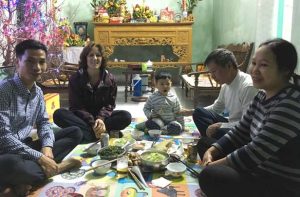
While I was a graduate student, I returned to the community in which I lived in Ifugao Province to conduct research for my dissertation which focused on malnutrition, particularly among women and children. I studied ways that hunger experienced by Ifugao people is influenced by gender, ethnic, and class inequality, global and local health and development programs, religious proselytization, political violence, and the state. I lived in Ifugao for almost four years. I resided in a wooden hut with a thatched roof in a small village for much of my stay there, as well as another more modern home, made of galvanized iron. I also periodically lived with a family in the center of a mountain town. I participated in the rich daily lives of farmers, woodcarvers, hospital personnel, government employees, shopkeepers, students, and other groups of people. I conducted interviews and surveys and also shared daily and ritual experiences with people to learn about inadequate access to nutritious food, and social structural sources of this kind of health problem. Participant observation research allows anthropologists to obtain a special kind of knowledge that is rarely acquired through other, more limited research methods. This type of research takes a great amount of time and effort but produces a uniquely deep and contextual type of knowledge. I published an ethnography about my research in Ifugao, titled Struggling with Development: The Politics of Hunger and Gender in the Philippines.
Influenced by my study of gender power relations surrounding hunger and malnutrition in the Philippines, and also by the political violence I witnessed by the Philippine government and the Communist New People’s Army, I took up a new research project that focuses on gender violence. I am exploring the impacts of this violence on the health and well-being of women and the intersecting global and local sociocultural forces that give meaning to and perpetuate gender violence in Vietnam. To address these issues, I am researching the abuse of women by their husbands, and in some cases their in-laws as well, in northern Vietnam. I also explore the ways in which abused women, and other Vietnamese professionals and government workers, contest this gender violence in Vietnamese communities. In Vietnam, I have had the opportunity to live with a family in a commune in Hanoi, and in nearby provinces. I learned about the deep pain and suffering experienced by abused women, as well as the numerous ways many of these women and their fellow community members have worked to put an end to the violence. Marital sexual violence is an important but understudied form of domestic violence in societies throughout the world, including in Vietnam.
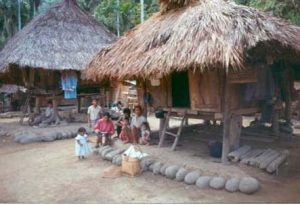
In recent decades, anthropologists have been reflecting on the significance and relevance of anthropological research. This has included anthropologists who are working in each of anthropology’s four subfields. Some anthropologists have called for greater efforts to share our anthropological findings with the public in order to try to solve significant historical, social, biological, and environmental problems. Examples of these problems include the impacts of climate change on the health and welfare of diverse peoples throughout the globe; and social structural reasons for nutritional problems, as well as cultural meanings people give to them, such as undernutrition, and illnesses related to increasing weights of people in societies globally. I hope my research on wife abuse will contribute to the emergence of a deeper understanding of the social and cultural sources of gender violence in order to end this violence, and greater awareness of its scope and its negative effects on women.
Through their research, anthropologists contribute unique and important forms of knowledge and information to diverse groups, including local communities, nations, and global social movements, such as feminist, racial, indigenous, environmental, LGBTQ, and other social movements. Cultural anthropologists’ research is unique because it often involves analysis of the intersection of global social, political and economic forces and the everyday experiences of members of a cultural group. The fieldwork and participant observation research methods provide cultural anthropologists the opportunity to live with a group of people for several months or years. They learn about the complexities of people’s lives intimately, including their social relationships, their bodily and emotional experiences, and the powerful institutional forces influencing their lives. Applying the results of our ethnographic research and making our research accessible to our students and the public can make the research of anthropologists useful toward alleviating the problems people face in our society, and in countries globally.
The particular way that cultural anthropologists do their research is important to our results. Through my research experiences I have participated in the rich daily lives of farmers, woodcarvers, hospital personnel, government employees, shopkeepers, students, and other groups of people. I conducted interviews and surveys and also shared daily and ritual experiences with people to learn about inadequate access to nutritious food, and social structural sources of this kind of health problem. Participant observation research allows anthropologists to obtain a special kind of knowledge that is rarely acquired through other, more limited research methods. This type of research takes a great amount of time and effort, but produces a uniquely deep and contextual type of knowledge. Ethnographic research can help us to understand the extent of a global problem such as gender violence, the everyday experiences of those facing abuse, and the struggles and accomplishments of people actively working to improve their societies.
Discussion Questions
- This chapter emphasizes how broad the discipline of anthropology is and how many different kinds of research questions anthropologists in the four subdisciplines pursue. What do you think are the strengths or unique opportunities of being such a broad discipline? What are some challenges or difficulties that could develop in a discipline that studies so many different things?
- Cultural anthropologists focus on the way beliefs, practices, and symbols bind groups of people together and shape their worldview and lifeways. Thinking about your own culture, what is an example of a belief, practice, or symbol that would be interesting to study anthropologically? What do you think could be learned by studying the example you have selected?
- Discuss the definition of culture proposed in this chapter. How is it similar or different from other ideas about culture that you have encountered in other classes or in everyday life?
- In this chapter, Anthony Kwame Harrison, Bob Myers, and Lynn Kwiatkowski describe how they first became interested in anthropology and how they have used their training in anthropology to conduct research in different parts of the world. Which of the research projects they described seemed the most interesting to you? How do you think the participant-observation fieldwork they described leads to information that would otherwise be difficult or impossible to learn?
GLOSSARY
Cultural relativism: the idea that we should seek to understand another person’s beliefs and behaviors from the perspective of their own culture and not our own.
Deductive: reasoning from the general to the specific; the inverse of inductive reasoning. Deductive research is more common in the natural sciences than in anthropology. In a deductive approach, the researcher creates a hypothesis and then designs a study to prove or disprove the hypothesis. The results of deductive research can be generalizable to other settings.
Enculturation: the process of learning the characteristics and expectations of a culture or group.
Ethnocentrism: the tendency to view one’s own culture as most important and correct and as the stick by which to measure all other cultures.
Ethnography: the in-depth study of the everyday practices and lives of a people.
Hominin: Humans (Homo sapiens) and their close relatives and immediate ancestors.
Inductive: a type of reasoning that uses specific information to draw general conclusions. In an inductive approach, the researcher seeks to collect evidence without trying to definitively prove or disprove a hypothesis. The researcher usually first spends time in the field to become familiar with the people before identifying a hypothesis or research question. Inductive research usually is not generalizable to other settings.
Paleoanthropologist: biological anthropologists who study ancient human relatives.
Participant-observation: a type of observation in which the anthropologist observes while participating in the same activities in which her informants are engaged.
ABOUT THE AUTHORS
 Katie Nelson is an instructor of anthropology at Inver Hills Community College. Her research focuses on migration, identity, belonging, and citizenship(s) in human history and in the contemporary United States, Mexico, and Morocco. She received her B.A. in anthropology and Latin American studies from Macalester College, her M.A. in anthropology from the University of California, Santa Barbara, an M.A. in education and instructional technology from the University of Saint Thomas, and her Ph.D. from CIESAS Occidente (Centro de Investigaciones y Estudios Superiores en Antropología Social –Center for Research and Higher Education in Social Anthropology), based in Guadalajara, Mexico.
Katie Nelson is an instructor of anthropology at Inver Hills Community College. Her research focuses on migration, identity, belonging, and citizenship(s) in human history and in the contemporary United States, Mexico, and Morocco. She received her B.A. in anthropology and Latin American studies from Macalester College, her M.A. in anthropology from the University of California, Santa Barbara, an M.A. in education and instructional technology from the University of Saint Thomas, and her Ph.D. from CIESAS Occidente (Centro de Investigaciones y Estudios Superiores en Antropología Social –Center for Research and Higher Education in Social Anthropology), based in Guadalajara, Mexico.
Katie views teaching and learning as central to her practice as an anthropologist and as mutually reinforcing elements of her professional life. She is the former chair of the Teaching Anthropology Interest Group (2016–2018) of the General Anthropology Division of the American Anthropological Association and currently serves as the online content editor for the Teaching and Learning Anthropology Journal. She has contributed to several open access textbook projects, both as an author and an editor, and views the affordability of quality learning materials as an important piece of the equity and inclusion puzzle in higher education.[9]
 Lara Braff is an instructor of anthropology at Grossmont College, where she teaches cultural and biological anthropology courses. She received her B.A. in anthropology and Spanish from the University of California at Berkeley and both her M.A. and Ph.D. in comparative human development from the University of Chicago, where she specialized in cultural and medical anthropology. Her research has focused on social identities and disparities in the context of reproduction and medicine in both Mexico and the U.S.
Lara Braff is an instructor of anthropology at Grossmont College, where she teaches cultural and biological anthropology courses. She received her B.A. in anthropology and Spanish from the University of California at Berkeley and both her M.A. and Ph.D. in comparative human development from the University of Chicago, where she specialized in cultural and medical anthropology. Her research has focused on social identities and disparities in the context of reproduction and medicine in both Mexico and the U.S.
Lara’s concern about the social inequality has guided her research projects, teaching practices, and involvement in open access projects like this textbook. In an effort to make college more accessible to all students, she serves as co-coordinator of Grossmont College’s Open Educational Resources (OER) and Zero Textbook Cost (ZTC) initiatives.
BIBLIOGRAPHY
Berger, Lee R., Hawks, John, de Ruiter, Darryl J., Churchill, Steven E., Schmid, Peter, Delezene, Lucas K., Kivell, Tracy L., Garvin, Heather M., and Scott A. Williams. 2015. “Homo naledi, A New Species of the Genus Homo from the Dinaledi Chamber, South Africa.” eLife 4:e09560. doi: 10.7554/eLife.09560.
Bourgois, Philippe. In Search of Respect: Selling Crack in El Barrio. Cambridge: Cambridge University Press, 2003.
Briggs, Jean. Never in Anger: Portrait of an Eskimo Family. Cambridge: President and Fellows of Harvard College, 1970.
Farmer, Paul. AIDS and Accusation: Haiti and the Geography of Blame. Berkeley: University of California Press, 2006.
Goodall, Jane. My Life with the Chimpanzees. New York: Aladdin Paperbacks, 1996.
Harrison, Anthony Kwame. Hip Hop Underground: The Integrity and Ethics of Racial Identification. Philadelphia: Temple University Press, 2009.
Jablonski, Nina. Living Color: The Biological and Social Meaning of Skin Color. Berkeley: University of California Press, 2012.
Kenyon, Kathleen. Excavations at Jericho – Volume II Tombs Excavated in 1955-8, London: British School of Archaeology, 1965.
Kwiatkowski, Lynn. Struggling with Development: The Politics of Hunger and Gender in the Philippines. Boulder: Westview Press, 1998.
Malotki, Ekkehart. Hopi Time: A Linguistic Analysis of the Temporal Concepts in the Hopi Language. Trends in Linguistics. Studies and Monographs. 20. New York: Mouton Publishers, 1983.
Mackintosh-Smith, Tim, ed. The Travels of Ibn Battutah. London: Picador, 2003.
Ochs, Elinor, and Bambi B. Schieffelin. 2012. “The Theory of Language Socialization.” In The Handbook of Language Socialization edited by Alessandro Duranti, Elinor Ochs, and Bambi Schieffelin, 1–21. Malden, MA: Wiley-Blackwell, 2012.
Rathje, William and Cullen Murphy. Rubbish: The Archaeology of Garbage. New York: HarperCollins Publishers, 1992.
Whorf, Benjamin Lee. Language, Thought, and Reality: Selected writings of Benjamin Lee Whorf. Edited by J.B. Carroll. Cambridge: M.I.T Press, 1956.
Wood, Frances. The Silk Road: Two Thousand Years in the Heart of Asia. Berkeley: University of California Press, 2004.
- Some of this chapter is adapted from the introduction to Explorations: An Open Invitation to Biological Anthropology: www.explorations.americananthro.org ↵
- See chapter two, The Culture Concept, for a history of the culture concept in anthropology. ↵
- Lahcen Mourad (Arabic scholar) in discussion with Katie Nelson, December, 2018. ↵
- https://www.nps.gov/afbg/index.htm ↵
- See the American Anthropological Association’s Code of Ethics: http://ethics.americananthro.org/category/statement/ ↵
- See: American Anthropological Association Statement of Purpose: https://www.americananthro.org/ConnectWithAAA/Content.aspx?ItemNumber=1650 ↵
- This quote is taken from a survey of students in an Introduction to Cultural Anthropology course at the Community College of Baltimore County, 2018. ↵
- The statue I'm standing next to in the photograph remembers the awful story of the Inuit High Arctic Relocations in the early 1950s, a textbook case of the ways Canada has abused Native peoples. Inuit from Inukjuak (formerly Port Harrison) in northern Quebec and Pond Inlet on Baffin Island were forced to move to Resolute and Grise Fiord in the High-Arctic territory that is now called Nunavut. The government’s promises of good conditions were deceptive and the Inuit struggled with a lack of shelter and food resources. Following the eventual public hearings in 1996, the Inuit were awarded a Can$10 million settlement. For more information see Melanie McGrath's The Long Exile: A Tale of Inuit Betrayal and Survival in the High Arctic. New York: Knopf, 2007. ↵
- See: http://perspectives.americananthro.org/ and https://textbooks.opensuny.org/global-perspectives-on-gender/ ↵
